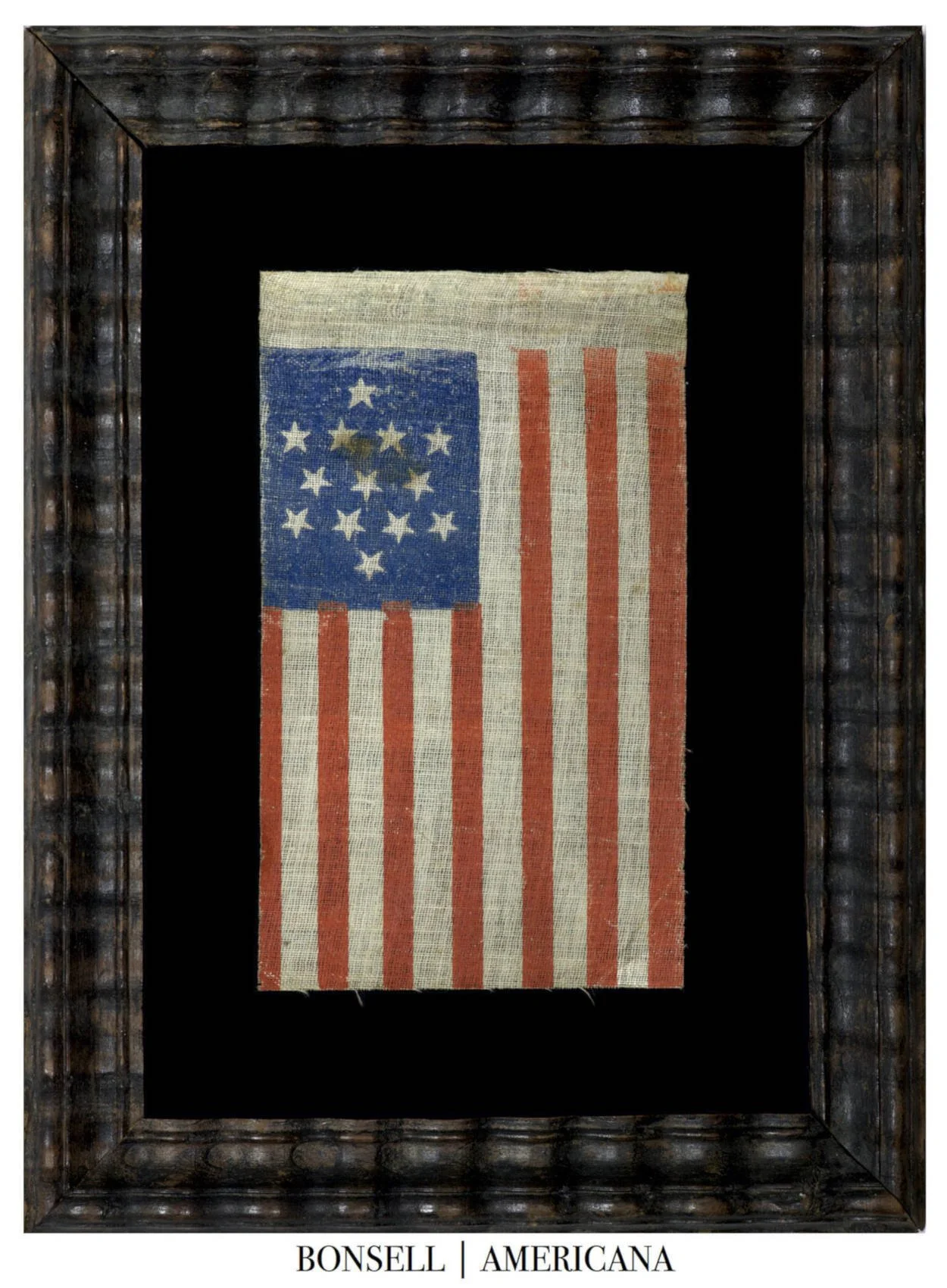Rare 13 Star Parade Flag with a Star of David Configuration | A Unique Display of American Patriotism with a Possible Religious or Heraldic Connection | Circa 1860-1890
Rare 13 Star Parade Flag with a Star of David Configuration | A Unique Display of American Patriotism with a Possible Religious or Heraldic Connection | Circa 1860-1890
Frame Size (H x L): 8.5” x 6.25”
Flag Size (H x L): 5.25” x 3”
Offered is a thirteen-star antique parade flag, dating to between 1860 and 1890, and exhibiting a rare six-pointed star pattern. This pattern defines a "Great Star," a term used to refer to a star made up of smaller stars. The inclusion of the six-pointed star is unusual and can likely be explained by one of two theories.
One theory suggests that the six-pointed star may represent the six-pointed star on the Great Seal of the United States. The Great Seal, as shown in one of the images, is used to authenticate documents issued by the Federal Government and dates to 1782. Francis Hopkinson played a key role in designing the Great Seal and is also credited by most historians with designing the United States' flag (not Betsy Ross). While the original sketches of the stars on the Great Seal were randomly placed, the engraver of the original die chose a six-pointed star design, influenced by English heraldry.
An alternative theory suggests that the six-pointed star may represent the Star of David, a symbol of modern Judaism, referencing the Biblical King and his shield. The Star of David has been used for centuries to mark ancestry and decorate books, among other things. However, starting in the 19th century, the Star of David became more widely used as a symbol of modern Judaism, particularly as European Jews integrated more fully into broader society. This timing is consistent with the age of the flag (1860-1890). In addition, the shade of blue in the canton is distinctive and similar to the shade used in representations of the Star of David, providing support for this second theory.
Whether this flag was made with one theory or the other in mind, what is certain is that it exhibits a configuration rarely encountered on a thirteen-star flag.
The original use of the thirteen-star flag dates back to June 14th, 1777, when the Continental Congress adopted a resolution creating the first official flag. The resolution stated, “Resolved, that the flag of the United States be made of thirteen stripes, alternate red and white, that the union be thirteen stars, white on a blue field, representing a new constellation.” Thirteen-star flags were official from 1777-1795, but have remained in use ever since.
Similar thirteen-star flags were flown during significant earlier events, including on small U.S. Navy boats from 1795 until 1916, at George Washington’s death in 1799, and during the nation’s 50th anniversary in 1824. They were also flown in 1824 to honor General Lafayette’s return to the U.S. for his nationwide tour, with celebrations held in New York, Boston, Philadelphia, and many other locations.
Additionally, thirteen-star flags were commonly used during the Mexican War (1846-1848) and the Civil War (1861-1865). These were highly patriotic periods, particularly during the Civil War, when the use of flags became much more widespread. Thirteen-star flags were also prominently displayed during the centennial celebrations, most notably at the Centennial International Exhibition in Philadelphia.
Conservation Process: This flag was hand sewn to cotton fabric, and both were hand sewn to a mounting board. To prevent the black dye in the cotton fabric from seeping into the flag, it was first washed in a standard wash and then in a dye setting wash. The flag is positioned behind Optium Museum Acrylic.
Frame: The antique ripple frame features evenly spaced, wavy ridges with a black finish and subtle highlights that create depth and texture. It dates to between 1850 and 1870.
Condition Report: The flag is in excellent condition overall, with a few small stains visible in the canton and minor creases that add to its antique character. Despite these slight imperfections, the flag remains well-preserved, retaining its vivid colors and historical integrity.
Collectability Level: The Great – Perfect for Rising Collectors
Date of Origin: 1860-1890
Number of Stars: 13
Associated War: The Civil War (1861-1865)
Associated State: Original 13 Colonies









